SOLITU Part D: Construction Tools and Drawings List
Copyright 2015, John Manimas Medeiros
Construction Tools:
Experienced geometers and mathematicians will not need these detailed directions.
Add a line to a line:
Use the open compass as the first line A (the distance from the pivot to the scribe). Mark that line length (number) on an extended ray (line). Then either close the compass a little or open it a little more to have that new distance between the pivot and the scribe be the second line length B (same as the number B). Mark the line length B from an end point of line A to the end point of line B. The new distance from the far end point of A to the far end point of B is the new line length C, which is the sum of A and B. Proportion is everything. And line lengths are numbers. A number is the name of a proportion that we invent the same as we invent names for all things in any language. Chair, horse, daisy, Billy, six, three-fourths, 25 divided by 24, or 0.96. All proportions that we sense or detect are useful, so we give them names. Our human mathematics is not a universal language. It is an international language, a cultural artifact agreed upon among many cultures in order for humans to have a common language that facilitates trade and political communications among different cultures. But it is a language, and an alien culture would not understand it. An alien culture would understand geometry and trigonometry, because proportion and geometry are the universal language. A square is a square anywhere in the universe, and a circle is a circle anywhere in the universe. But, an alien species does not know that " = " means "equals" or "is equal to" until they are told that is the meaning of " = " in the human mathematical language. (No drawing deemed necessary)
Subtract a line from a line:
Essentially the reverse of add a line to a line. First construct a long line with its two end points. That line can be labelled line C. Then set the compass to enclose a distance that is less than the line length C. With the pivot on one end point of line C, mark off the length of the shorter line A. Let the remaining section of line C be labelled line B. This construction clearly demonstrates that the subtraction of line A from line C results in a difference of line length of B. (No drawing deemed necessary)
Divide a line into two equal lines, and construct a perpendicular:
One of the first powerful construction procedures that children learn in school. Construct a line length on a page with its two end points, X and Y, line A. Keep the compass open to a distance that is slightly more than one-half of the length of the line A. This can be done by using one's eyes to identify a length slightly more than one half of A. Set the pivot at end point X of A and swing the scribe to mark a long arc, or two separate shorter arcs on either side of line A. Then set the compass pivot at the opposite end point Y of line A, and again use the same compass distance to mark a long arc or two separate shorter arcs that intersect with the previous arc or pair of arcs. Then use the straightedge to construct a line from the point of intersection of one pair of arcs to the point of intersection of the other pair of arcs. That newly constructed straight line (line B) is perpendicular to line A and the point of intersection of lines A and B divides line A into two equal halves. Nature does this all the time, halving and doubling is the basic operation of genetics. Halving and doubling is the natural process of the binary number system.
Dividing a line in half
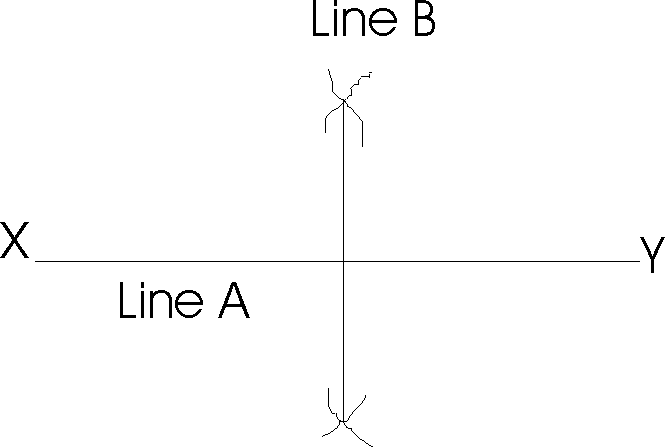
Divide an angle in half (also constructs a perpendicular):
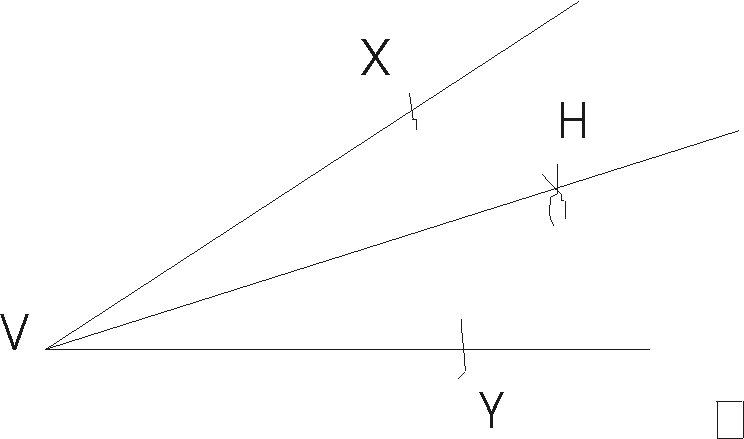
Given angle V, open the compass to a suitable distance, and then with the pivot on the vertex V of the angle scribe an arc that intersects both arms of the angle, equidistant from the vertex, at points X and Y. Then open the compass to a distance that is slightly more than one half of the distance between X and Y. With the pivot on point X, scribe an arc approximately midway between the arms of the angle. Then with the pivot on point Y, scribe an arc approximately midway between the arms of the angle so that this second arc intersects the first arc at H. With the straightedge, construct a straight line from the vertex V to the intersection of the arcs H. That line from V to H divides the original angle into two equal angles.
Reconstruction of an angle (step toward construction of similar right triangles):
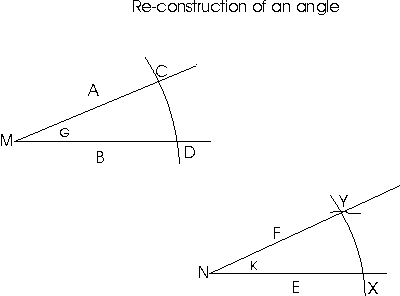
Given angle G, lines A and B meeting at vertex M, construct straight line E where needed. Locate new vertex N on E. On given angle, open compass to useful radius (R), with pivot on vertex M, draw the arc across both sides of the given angle (points C and D). With the compass pivot at point N on line E, draw that same arc across and above line E (creating point X on line E). With the compass pivot on point C on the given angle, open the compass scribe to point D on the given angle. With this new radius of distance between C and D, place the compass pivot on point X on line E and draw the new arc to intersect the other arc that was previously drawn with the pivot on point N. Designate that point of the intersection of the arcs as point Y. Then, construct the straight line from vertex point N to point Y, that line being line F, and therefore line E and F meeting at vertex N create the same angle as the original angle G. Angle K = angle G.
Multiplication of ratio times a line length (see SRT Table below):
Note: I usually use the asterisk * as the multiplication sign, 3*2 = 3x2.
There are several ways to convert the value of a line length to a ratio by using the SRT Construction Table below. This is one example. Construct the starting line length (SL) such as 2.3, or 1.414213562... or 1.732050808..., as side A1 (Altitude) of a right triangle and side B1 (Base) as line length of 1. The tangent of that right triangle is then equal to the length of side A1. The inverse ratio of 1/A1 is therefore the cotangent. Having constructed this ratio, we can now multiply this ratio by another value (X) by constructing a similar right triangle with side B2 having a line length of X. Side A2 in our similar right triangle will then have a length equal to X*tangent, and the tangent equals our original side A1. Therefore, X*tangent = A2 = X*A1. Any line length X can be converted to a ratio equal to that line length by constructing a right triangle with Altitude A = X and Base B =1.
Raise a perpendicular, from a given point on a horizontal line:
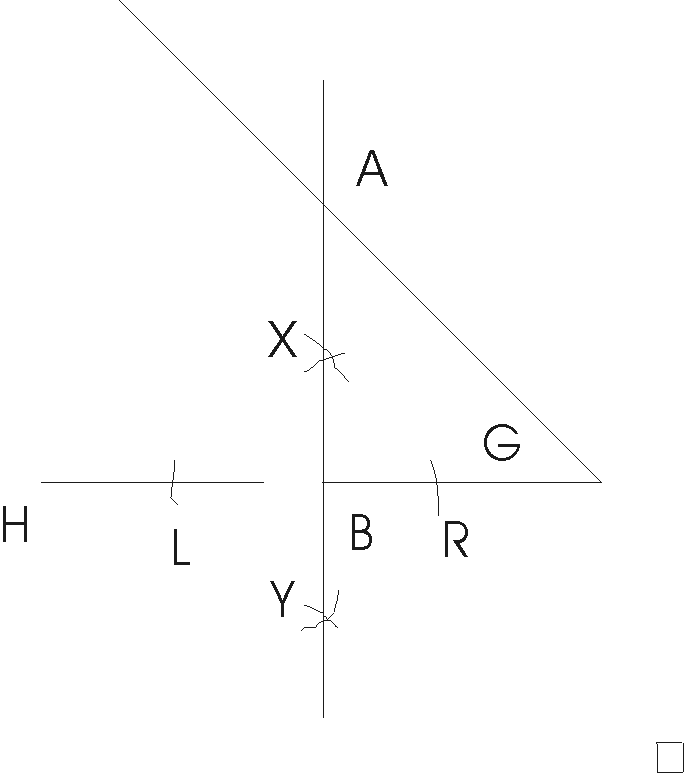
Raise a perpendicular, narrative of steps:
Reconstruct angle G to the right with the extended lower horizontal arm H and the extended upper angle arm A. Open the compass to selected distance (length) of the Base to end point B.
Place the pivot of the compass on point B and scribe an arc to the left and an arc to the right creating two intersections, L and R, on the horizontal H that are each equidistant from point B. Then place the pivot of the compass on point L and scribe a pair of arcs above and below point B. Then place the pivot of the compass on point R and scribe a pair of arcs above and below point B so that this second pair of arcs intersect with the first pair of arcs, creating new points X above the horizontal and Y below the horizontal. Use the straightedge to construct a vertical straight line from Y to X and extended upward to intersect with the upper arm of the angle at point A. The line length from B to the vertex is the selected Base length and the vertical is the Altitude that is perpendicular to the horizontal line H and is now the Altitude A of the similar right triangle with angle G that has the three sides proportional to all right triangles constructed with angle G.
Drop a perpendicular, from a given point above a horizontal line:
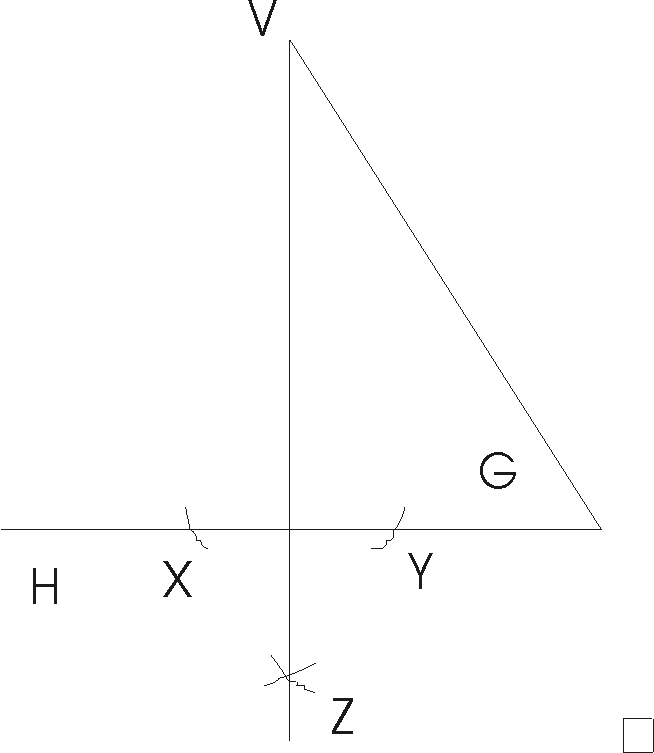
Drop a perpendicular, narrative of steps:
Reconstruct angle G to the right with the extended lower horizontal arm H and the extended upper angle arm. Open the compass to selected distance (length) of the hypotenuse C and place the pivot of the compass at the vertex of angle G and mark off the length C from the vertex of angle G to the upper end point V. Open the compass to a suitable distance and place the pivot of the compass on upper end point V and scribe an arc to the left and an arc to the right creating two intersections, X and Y, on the horizontal H that are each equidistant from upper end point V. Then place the pivot of the compass on point X and scribe an arc below the horizontal H and approximately below V. Then place the pivot of the compass on point Y and scribe an arc below the horizontal H and approximately below V and intersecting with the previous arc at point Z, that intersection Z being equidistant from points X and Y. Use the straightedge to construct the vertical line from point Z to the upper vertex end point V. That vertical line is perpendicular to the horizontal line H and is now the Altitude A of a similar right triangle constructed with angle G and that has its sides proportional to all right triangles constructed with angle G. The new base will also be in the fixed proportion to the selected hypotenuse length C that applies to all right triangles with angle G.
Multiplication by construction of similar right triangle, example in three steps A, B, C:
Also see the Similar Right Triangle Table (SRT) below.
Mathematics is speed geometry. We can perform all of the following mathematical operations using only the compass and straightedge, where every value is a proportion, but also rendered as a number in the form of a line length. We can complete addition, subtraction, multiplication, division (multiply by a fraction or inverse ratio), take the square root of a product, by squaring the rectangle (L * W) = S^2, and take the square root of any value by squaring the rectangle, where one dimension is 1 (L * W=1), square a value by multiplication.
Multiplication construction A: A1 = 6 … B1 = 5 … therefore tangent G = 1.2
and angle G = 5019442891… .

Multiplication construction B: In this similar right triangle, B2 = 1 … G2 = G1 …
and tangent G2 = 1.2, therefore A2 = 1.2. By construction of angle G1 in a right triangle with Base B2 = 1 marked off with the compass, followed by raising a perpendicular at the left end-point of Base B2, we get the Altitude A = 1.2, the value of the tangent.
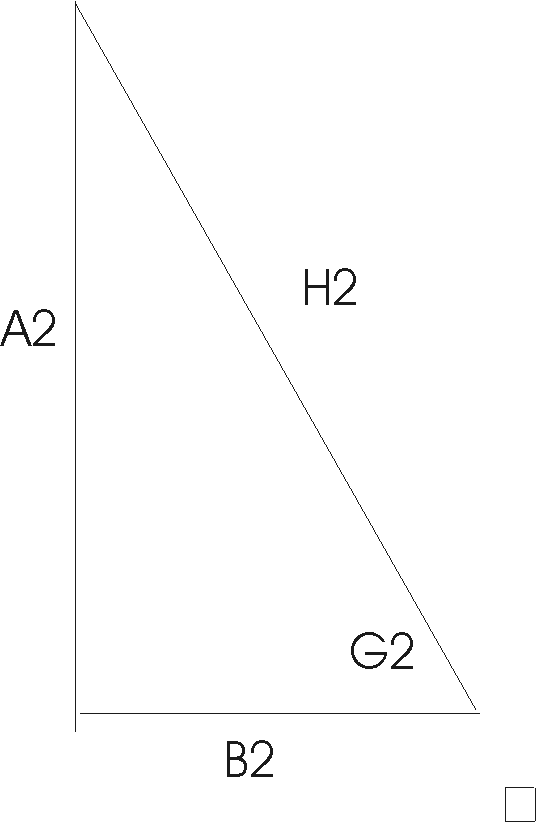
Multiplication construction C: In this similar right triangle, B3 = 1.5 … G3 = G1 … tangent = 1.2, therefore A3 = 1.8. By reconstruction of angle G1 in a right triangle, with Base B3 = 1.5, we get the Altitude A3 = 1.5 x 1.2. We therefore perform the operation of multiplication with the compass and straightedge and the Similar Right Triangle Table.

SIMILAR RIGHT TRIANGLE (SRT) TABLE OF MULTIPLICATIONS
sin = A/H = 1/csc csc=H/A = 1/sin sin G = cos OPP csc G = sec OPP
cos= B/H = 1/sec sec=H/B = 1/cos cos G = sin OPP sec G = csc OPP
tan= A/B = 1/cot cot=B/A = 1/tan tan G = cot OPP cot G = tan OPP
S=sine CS=cosecant C=cosine SC=secant T=tangent CT=cotangent
If A=X H=X * CS H= X/S H=B * SC H=B/C
B=X * CT B=X/T B= H * C B=H/SC
If B=X, H=X * SC H=X/C H= B * SC H= B/C
A=X * T A=X/CT A=H * S A=H/CS
If H=X, A=X * S A=X/CS A=H * S A=H/CS
B=X * C B=X/SC B=H * C B=H/SC
and X * sin = X/csc X * csc = X/sin
X * cos = X/sec X * sec = X/cos
X * tan = X/cot X * cot = X/tan
Conversion to functions of sides: (S1=side 1) (this section optional)
S1=A1 S2=B1 S3=H1
S4=A2 S5=B2 S6=H2
A2... B2=(A2*B1)/A1 H2=(A2*H1)/A1
B2... A2=(B2*A1)/B1 H2=(B2*H1)/B1
H2... A2=(H2*A1)/H1 B2=(H2*B1)/H1
S4=A2... B2=(A2*B1)/A1 H2=(A2*H1)/A1
S5=B2... A2=(B2*A1)/B1 H2=(B2*H1)/B1
S6=H2... A2=(H2*A1)/H1 B2=(H2*B1)/H1
S4=A2... S5=(S4*S2)/S1 S6=(S4*S3)/S1
S5=B2... S4=(S5*S1)/S2 S6=(S5*S3)/S2
S6=H2... S4=(S6*S1)/S3 S5=(S6*S2)/S3
if S4=A2... S[x+1]=(S[x]*S[x-2])/S[x-3] S[x+2]=(S[x]*S[x-1])/S[x-3]
if S5=B2... S[x]=(S[x+1]*S[x-3])/S[x-2] S[x+2]=(S[x+1]*S[x-1])/S[x-2]
if S6=Hy2... S[x]=(S[x+2]*S[x-3])/S[x-1] S[x+1]=(S[x+2]*S[x-2])/S[x-1]
(this section clarifies)
To restate briefly the reality of re-constructing right triangle angles and sides:
Construct A, and: A=A B=A*cotangent H=A*cosecant
Construct B, and: A=B*tangent B=B H=B*secant
Construct H, and: A=H*sine B=H*cosine H=H
Divide a line by a ratio (or a line value) -- similar right triangle [table]:
This construction procedure is similar to the multiplication construction except for the simple difference that the ratio is the inverse of the multiplier, which results, obviously, in multiplication by the inverse ratio or fraction. Invert the ratio 3 to 1 to get the ratio 1 to 3 or one third, and so forth. In this example, X * (1/3) is of course X divided by 3.
Square the rectangle, which enables taking the square root of a line value or ratio:

Square a rectangle:
Remember that all rectangles and squares are parallelograms. Figure BCDE is a rectangle that I have constructed to represent BE and CD as a length of 2.5, and BC and DE as a width of 1. That makes the area of the rectangle 2.5. To construct a square of the same area, our first step is to extend the perpendiculars at E, line DE upward, and line BE to the right a distance greater than the width of the rectangle. Use the compass and place the pivot at intersection E and open the compass to the width of the rectangle. Then mark the same distance (width of the rectangle) on the line EF extended to the right. Now we treat the new line BF as though it were the diameter of a circle, and we bisect it to obtain the center G, so that BG = GF the radius of the circle. Use the compass to construct the upper half circle centered at G. It is not necessary to construct the lower half of that circle. The point H at which the extended DE vertical perpendicular intersects the circumference of the half circle is the length of the side of the square with an area of 2.5. Using the compass and straightedge, construct side HL parallel to EK and side LK parallel to EH. A measurement of the sides of the square, depending on the precision of construction, would show that the length of the side is the square root of 2.5 or 1.58113883... . There is also a statement (proof) that shows that for the sides of the right triangle a(T), b(T), c(T), c^2 = a^2 - b^2 , and the area of the rectangle equals BE * ED and that equals BE * EF, and line BE = (a+b) and line EF = (a-b), and therefore because c^2 = a^2 - b^2, c^2 also equals BE * EF the area of the rectangle. This is all beautifully described on pages 13 and 14 of Journey Through Genius, by William Dunham. It is also described in many other books about geometry, trigonometry and mechanical drawing or drafting.
Square root of a product of two values:
This procedure is similar to the procedure for the square root of a given value SV, but in this case our starting value is the product of two values. For example, if we have a line length of 5.5, and we want to construct a line length that is the square root of (3.3 * 5.5), (18.15), we begin by constructing a rectangle with width of 3.3 and length of 5.5.
Construct the square of a line value or number (by multiplication):
This construction procedure is the same as the multiplication procedure except that we must convert a line length to a ratio, such as line length X divided by 1, or tangent = X. Then we use the SRT method to construct the line length X times the ratio X which results in the new line length of X^2. Refer back to the Similar Right Triangle constructions.
The Pentagon and Evolutionary Proportion
Construction of the Pentagon and Pentangle (Phi related ratios and lines):
The Pythagoreans understood the meaning of the "Golden Mean" or "Golden Section" which is the proportional sign that humans recognize in living things, such as vines, sea shells, and the proportions of an animal's body, including the human body. The ancients said that the golden section proportion of Phi to 1 or Phi to Phi-squared in a drawing or painting was "pleasing to the eye." Actually, the golden mean was and is a signal of realism in any picture or image. They knew that Phi is 1.618033989… or two times the cosine of 36 degrees: 0.809016994… . When we go through the steps to construct a pentagon and then a pentangle, we observe what really is an introduction to Evolutionary Proportion.
Drawing #1:
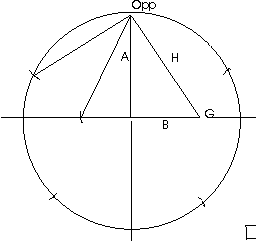
The steps required to construct a pentagon are more than the procedure to produce a five-sided regular polygon. It is the proper beginning for any and all geometric constructions. It is also, according to my theory of Evolutionary Proportion, the way the universe unfolds. Traditionally, the immediate and essential characteristics of this construction are:
1) The right triangle is constructed in the upper right quarter or quadrant of the circle, with the Base B being on the horizontal diameter or right horizontal radius.
2) The ratio of the Altitude A to the Base B is 2, making the tangent 2 and the length of the hypotenuse equal to the square root of 5, sqrt(5). HOWEVER, I will show later that this method of starting a geometric construction has a hidden history. And if we make a couple of subtle but transformative changes in this same construction, we can see what may actually be the lost Hiram Key (SOLITU H), a set of trigonometric relationships that have the effect of establishing that the Base B is not one (1) by arbitrary designation but in fact is one and must be 1 in proportion to all other lines in the construction. This is significant because it makes the construction of the one NATURAL, A FACT OF Nature rather than a subjective human selection.
Getting back to our traditional and reliable facts about the tangent=2 right triangle, we will use the pentagon construction to enable us to construct a small set of "pi-lines." The pi-lines are straight line lengths that are slightly less than or slightly greater than pi exactly. These pi-lines are very useful. They lead to the solution of the riddle: pi exactly constructed as a straight line. The pi value exists in Evolutionary Proportion, in the real, physical universe consistent with the conventions of human mathematics and any system or language of mathematics. That is why the ancient Pythagoreans said "Proportion is everything." Because pi is included in proportion. Because we can construct a straight line that is pi exactly, and the inverse, and the square root of pi, and the square root of one over pi, and all squares and circles that are exactly equal in area. And there will be more still. Don't run away with a handful of gold rings. The real treasure is much greater and is yours if you go all the way to the end of the cave.
A) With the Base B = 1 and the Altitude A = 2, the Hypotenuse H = sqrt(5). We use our compass to "lay down the hypotenuse" on the diameter, marking the distance of sqrt(5) from the right vertex of the tangent=2 right triangle to intersect with the horizontal diameter in the left half of the circle.
B) We then use our straightedge to construct a straight line from the upper vertex down to the intersection of the hypotenuse length [sqrt(5)] with the left horizontal diameter. Now we have two right triangles, as shown in our first construction and below in the next construction. The left right triangle has a Base B = [sqrt(5) - 1] or 1.236067977, which is equal to the secant [inverse of the cosine] of 36 degrees. The Altitude A is the common Altitude = 2. Therefore, the tangent of this left side right triangle is 1.618033989, the same as the cosine of 36 degrees (0.809016994) times 2 and the value know as Phi, or as the Golden Section or the Golden Mean. I sometimes use "Phi" as the name for the larger value 1.618033989 and "phi" as the name for little phi, or 0.618033989, although these two values are inverses. Phi is the same as the sum of the infinite Fibonacci series [1, 2, 3, 5, 8, 13, 21, 34, 55, 89, etc] [K/(K-1)]. For example, (89/55) = 2.618181818, the same as the ratio of (1.44/0.55). And, this value 1.618033989 minus 1 is its own inverse, and this value squared = itself plus 1 or 2.618033989. I plan to show you later in a separate document that by treating the quadratic equation as the quadratic construction, plus using another equation or two, we actually can construct any value N squared equals itself plus a target value X. In other words we can construct any N such that N^2 = N + 3 or N^2 = N + 1.75, and so on. Phi is a special case of N^2 = N + X where X = 1.
C) The Hypotenuse H of our left side right triangle equals the square root of (4 + 1.527864045) or 2.351141009, which equals 4 times the sine of 36 degrees (4 * 0.587785252). This may all seem tedious, but it is the tedium of the real, physical universe. Nature is tedious. It does the same thing over and over again. Nature is cyclical. We humans are just like everything else in the universe. We also do the same things over and over again. Our vision of human separateness from Nature, our alleged "exceptionalism," is a dangerous illusion.
D) We swing that hypotenuse outward to the upper left, using the compass to mark that hypotenuse distance (2.351141009) with an arc on the circumference of the circle. Then with the straightedge we construct the straight line from that arc back to the intersection of the top of the vertical diameter with the circumference of the circle. That straight line, with a length of 2.351141009, is the side of our pentagon. We can then use the compass opened to that distance to construct the other four sides. They often do not meet up perfectly because of the margin of error inherent in our instruments and our own visual and dexterity limitations. The pentagon is shown in Drawings #3 and #4, the pentangle in Drawing #5.
Drawing #2:
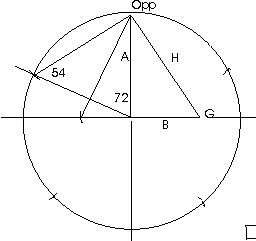
If we construct a straight line from the circle center to the end point of the side of the pentagon, we then see one-fifth of the pentagon, each central angle of the five triangles being 72 degrees (360/5) - see drawing above. And, if we divide that isosceles triangle in two at the 72 degree vertex (dividing the angle in half), we will then have two 36-54 degree right triangles.
Drawing #3:
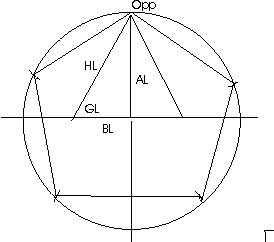
Drawing #4:

Drawing #5:

E) Looking at the drawings, we have our pentagon and the pentangle that is constructed within the pentagon. Here below is the table of lines and ratios we have constructed, and which we could re-construct again, as needed, all in proportion to our original line length of B = 1.
The tangent = 2 right triangle:
A = 2, B = 1, H = 2.236067977
Sine = 0.894427191 or sqrt(4/5), Cosecant = 1.118033989 or sqrt(5/4)
Cosine = 0.447213595 or sqrt(1/5), Secant = 2.236067977 or sqrt(5)
Tangent = 2, Cotangent = 0.5
Angle G = 63.43494882, Opposite = 26.56505118
The tangent = 1.618033989 (Phi) right triangle:
A = 2, B = 1.236067977, H = 2.51141009
Sine = 0.850650808, Cosecant = 1.175570505
Cosine = 0.525731112, Secant = 1.902113033
Tangent = 1.618033989, Cotangent = 0.618033989
Angle G = 58.28252559, Opp = 3171747441
Note that the secant 1.902113033 is equal to 2 times the cosine of 18 degrees or 2 times 0.951056516, and the sine of 18 degrees is phi/2 or 0.309016994, the same as cosine 36 minus 0.5.
For any 36-54 right triangle:
Sine = 0.587785252, Cosecant = 1.701301617
Cosine = 0.809016994, Secant = 1.236067977
Tangent = 0.726542528 Cotangent = 1.37638192
All of the preceding constructions in this Part D are our set of tools in our trigonometric tool box which we can use to construct the set of pi-lines that lead us to construction of a straight line equal to pi exactly. IMPORTANT NOTE: You can now verify the constructions without making them on paper. You don't even need to have a compass and straightedge. Use a hand-held scientific calculator (with trigonometric functions). Or, find "calculator" on your computer, often found as one of the "accessories," and select "view" then select "scientific."
It is also of the greatest importance that the viewer understand there is no new or unique construction discovered or invented in order to construct a straight line equal to pi exactly. Only the well-known established constructions referenced here are needed. This means that the definition and meaning of pi is changed. Now we know that pi is a proportional number, like the square root of 5 and Phi (2 times the cosine of 36 degrees). This is my discovery, which is a discovery in regard to the meaning of proportion and this new discovery overturns the position of Ferdinand Lindemann, who persuaded mathematicians that pi is a "transcendental" number that could not be constructed (1884).
